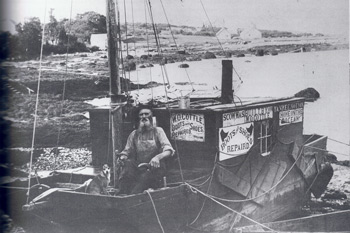BACK THEN
Isle au Haut, Late ’90s

Photo courtesy of Isle au Haut Historicl Society
The queerest looking craft that has visited these waters for a long time arrived in port last Friday. It is a small scow built this past winter at Swans Island by Capt. William Cottrell [sic], who makes his home on board and earns his livelihood by going from place to place doing odd jobs of cobbling…. Capt. Cottrell is lame and uses crutches to get aboard. His only shipmate is a small yellow dog. He calls his vessel the Yankee Notion. – The [Belfast] Republican Journal, in The [Bangor] Industrial Journal, June 26, 1896.
George Wasson wrote that Captain Cottle was a frequent visitor to Isle au Haut, blowing in with a dead fair breeze. The scow’s house was painted blue, with yellow signs. Cottle rounded his vessel at the old lobster factory, where he pegged away at his trade.
In 1899, a reporter described Cottle as a “used-up man” with a withered arm and leg. Aged fifty-five, he was described as a Jonesport native who had sailed on Ellsworth schooners. He had built the scow unaided from odds and ends of wood and declared her a handy packet that steered herself with the tiller in beckets. (She was fitted with leeboards, termed “weathereboards” – whether, in fact, she went slashing to “to weather” is another matter.) Cabin doors lashed open provided a view ahead from the helm. Snips, the dog, was Cottle’s bunkmate.
Captain Frank Delano recalled that when he was a boy a cobbler with a vessel answering the description of the Yankee Notion laid over at Verona Island one night in the spring of 1896. The cobbler’s wife and daughter were aboard, and they accepted an invitation to spend the night with the Delanos with alacrity. Evidently the scow’s rating as a “hen frigate” – a vessel with the master’s wife aboard – did not last long.
While it is easy to make fun of Cottle’s lash-up, in truth, his enterprise in the face of adversity is wholly praiseworthy. It was also wholly typical of a time when but very few people (aside from Civil War veterans) received any formal public assistance.
While Cottle’s outfit was considered novel enough to interest reporters, there were a variety of entrepreneurs floating about in small craft. Just as peddlers of every stripe roamed the interior countryside, their brethren of the coast flogged wares and services to isolated coastal markets on island and peninsula. On the coast the lowly immigrant pack peddlers enjoyed a strategic advantage over their horse-drawn competition, and every spring descended as a swarm, shifting about by steamers, fishing craft, or chartered or borrowed dory, skiff or peapod.
On Penobscot Bay an elderly liniment salesman aboard a catamaran staged magic lantern shows and displayed a stuffed alligator in island school houses. A physician made his rounds by catboat. In 1897, eleven men and four women, comprising a variety and vaudeville company, chartered the schooner Pearl for a tour. A sloop manned by Mormons cruised about in search of converts. Another sloop comprised a floating jewelry shop. Other sloops, often changing color from day to day, ran rum to thirsty island quarrymen. Every September the sloop of a dark and dismal holyman appeared out of the fog to reclaim the pulpit of the Isle au Haut church, vacated by its summer shepherd, usually a Bangor Theological student sent out to practice on the captive flock.
And the there was the itinerant artist, J. Ellingwood Stubbs, aboard his fantastically decorated sloop Lola Montez. Stubbs specialized in dramatic seascapes, but if the masterpiece market was dull, happily applied paint or gold leaf to the decorative carvings and cove lines of the local sloops.
At least once a summer Isle au Haut was visited by a “trader,” a small schooner wide of beam, shoal of draft, and long of tooth, fitted out as a floating general store. A small house, shingled and clapboarded, built between the masts, was jammed with shoes, knives, jewelry, soap, candy, and all manner of dry goods. In the hold, entered through a trap door and dimly illuminated by lanterns, were discovered molasses hogsheads, kerosene barrels, wash tubs, crockery, and so on. Payment could be made produce, old iron, cordage or sails. The last of the traders were Mom and Pop operations. They chose their weather with care, for not only was the vessel likely a ripe old basket, but the effect of a rough passage could be disastrous to inventory.
Text by William H. Bunting from A Day’s Work, A Sampler of Historic Maine Photographs, 1860-1920, Part I. Published by Tilbury House Publishers, Gardiner, Maine, 800-582-1899
